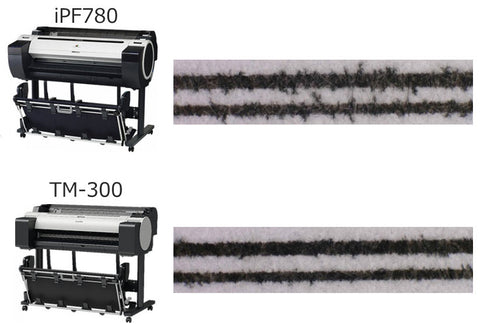[ Free Consultation ] Are you interested in exploring options for a new large-format printer but don't know where to start? Get help from our top tech experts in a free consultation call.
Click Here to Schedule Your Free Consultation Call
Do you want your large format prints to pop, be durable, and resist fading?
The obvious solution is to use the correct print technology for the best results. For instance, use photo paper for a large photo image, vinyl for banners, etc. But, one often overlooked aspect of printing the perfect image is the ink itself.
The secret to printing awesome large-format photos or graphics has just as much to do with the quality of the ink as the print material. This is why Canon has spent so much time researching and developing the best technologies for word-class prints. Check out how Canon has elevated the playing field with their LUCIA ink sets for Canon large-format printers.
So, inkjet printing is not new. It was first conceptualized in the 1950s and brought to market in the 1970s by HP and Canon. As per IJT Direct:
The concept of heating a substance to a high temperature to create energy for other processes, or thermal excitation, which in the case of printing was intended to move tiny drops of ink was developed by 2 parties, completely independently of one another around roughly the same time. These two parties were John Vaught and his team at HP's Corvallis Division, and Ichiro Endo, a Canon engineer. In 1977, Endo and his team initially experimented with the piezoelectric method of ink delivery from the nozzle. They accidentally stumbled up on an extreme reaction while using a soldering iron to heat the ink. In doing so the heat caused the ink to shoot out of a syringe.

Photo credit: dp3project.org
See the selection of Canon plotter ink tanks and cartridges available from TAVCO.
Dye-based Plotter Ink
Traditionally, most inkjet printers use dye-based inks. The justification has always been a more comprehensive color range and lower cost. But dyes are pretty volatile; they are merely watercolors. Dyes are completely water soluble and can significantly be affected by the environment - incredibly ultraviolet light (UV) and moisture.
This is usually a perfectly cheap and efficient process for general-purpose printing. Most large-format printers use dye inks for CAD and other basic printing applications.
Once these dye-based prints are exposed to the elements, dye inks can fade in sunlight or bleed when they get wet. These changes can also happen suddenly.
Conversely, photographers and other graphics professionals need and expect better image quality, durability, and longevity from their prints. Because of this, professional photo printers, such as the Canon PRO-4600, use pigment-based inks exclusively.
Pigment-based Plotter Ink
Unlike dyes, which are essentially colored water, pigments are formulated as emulsions.
The pigments are microscopic solid particles suspended in an aqueous (water-based) liquid solution.
These solid particles are durable and resilient and do not break down because of environmental conditions. Pigments will not fade and are primarily water-resistant. The new Canon LUCIA inks are designed to resist scratches and minimize bronzing (distorting the reflection of light off of a print).
Although pigment inks differ from dyes, the printing process is the same. Pigment inks are shot onto the media as dye inks via an inkjet print head.
The difference is that dyes will soak into the paper, but pigments adhere and cure to the surface of the media. In addition to more excellent durability, pigment-based inks produce much better overall image quality. 
Pigment inks deliver stunning results with fantastic durability.
Canon’s Pigment Plotter Ink Technology
Over the past few years, Canon has made great strides in advancing the ink technologies of its entire large-format printer series.
This includes high-quality graphics models and the more commonly used systems for CAD, GIS, and other business printing needs.
Canon LUCIA TD Inks
All five ink channels are pigment-based in the Canon TX and TM printer series.
Both the TX-Series and TM-Series printers use refined and improved ink sets. The printers utilize five colors (C, M, Y, Bk, MBk).
However, unlike previous versions, every ink in the set is now a pigment ink. This LUCIA TD pigment ink allows for fantastic, high-quality prints on coated inkjet media and standard bond papers.
These new inks have fantastic black density and strong bleed resistance, so contractors can use these prints worry-free in the field.
They will not fade in the sun, and a rainstorm will not completely ruin the construction drawings. Another benefit to the bleed resistance of the TD Inks is that their drawings can be highlighted and marked up without any smearing.
Also, TX Series printers produce a wider color gamut compared to the earlier Canon imagePROGRAF 750/760/780/830/840/850 series.
This means that renderings, maps, and aerials look better than ever. Plus, excellent durability can be achieved by printing on tough, long-lasting media such as water-resistant matte polypropylene, vinyl banner, or Tyvek.

Canon LUCIA PRO Inks
When image quality is paramount, Canon PRO inks deliver. This new ink formulation is found in Canon's family of PRO-Series and PRO-S-Series printers.

The Canon LUCA PRO ink set includes 11 colors plus a Chroma Optimizer.
The LUCIA PRO ink set consists of newly formulated 11-color pigment inks plus a Chroma Optimizer.
These inks are designed to meet the demands of even the most critical photographers and graphic artists. This ink offers increased pigment density for richer color expression.
The Chroma Optimizer (CO) works like a “clear coat” layer when printing on photo papers. It enhances the quality further and ensures uniformity of light reflection.
This unique ink system helps enable a broad color gamut with more delicate details in dark areas and improved gloss uniformity. The new LUCIA PRO ink set also significantly reduces bronze and graininess.
Whether recreating an artistic masterpiece or printing a set of construction drawings, the new Canon pigment inks will help you achieve much more outstanding results.
The Canon LUCIA PRO, LUCIA TD, and LUCIA TM inks provide a wider color gamut and produce highly durable prints, offering better peace of mind.
Canon pigment inks are durable and can survive the elements. Drawings, pictures, and posters will not fade.
Combine the inks with more durable printing material, such as polypropylene, and your print can even be used for short-term outside display.
Upgrade your printing game and achieve exceptional results with a Canon plotter using a complete pigment ink set.
Content updated: 8-9-24
You Can Count on TAVCO
In the complex landscape of AEC, you need a vendor as committed to quality and reliability as you are. TAVCO offers just that—high-performance tools like our durable large-format plotters, cutting-edge 3D scanners, and innovative software solutions.
We build long-term relationships fortified by unwavering support and innovative solutions that keep you ahead of the curve. Plus, when you have questions or need advice—including cost-effective options—you can always speak directly with a live TAVCO specialist, not a bot or an automated attendant.
👇👇👇
Ready to take the next step? Chat with a TAVCO specialist today to tailor solutions for your unique needs.
🛒 Or explore our range of products at www.tavcotech.com.
Sources:

July 8, 2020


Comments